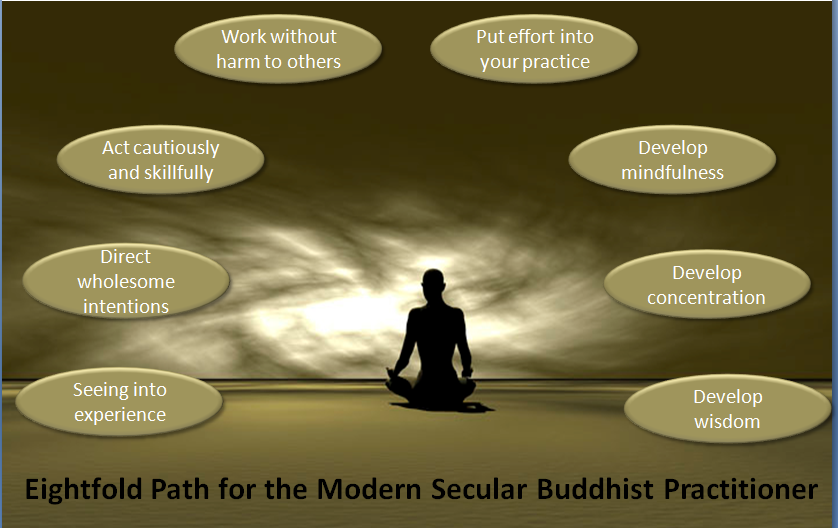The Path – Reworded for Modern Practitioners
I was never comfortable with the wording in the Eightfold Path. The word Right xx always felt like it implied following of dogma rather than an action packed plan. Because Buddhism relies so heavily on practice and observation, I felt each part of the path was better reworded for me with verbs, and action statements.
The diagram below is not intended to be “the way.” It’s simply wording I found helpful for my own practice. I welcome your feedback on better ways of wording it. And, of course, many of you are hunky-dory with the classic wording and that’s fine too, because what’s really useful is going on this journey we call the Eightfold Path.
Below the diagram are some observations I’ve made for those of you who may not be familiar with the path.
The path is not practiced in linear fashion, but instead all areas are examined and practiced simultaneously to the best of one’s ability. Some activities of the path can not be practiced well without other parts.
For instance, mindfulness and effort is needed for all areas of the path, and through the development of mindfulness and effort, you naturally open to a more realistic view of yourself, others, and the world around you. Effort and mindfulness leads to being aware of your intentions, so you can direct them in a wholesome way and act with caution and skill. Acting skillfully also includes how we speak to people, treat others and animals, etc. All of this works towards developing wisdom, and wisdom of course aids in the entire path itself.
A special note on Seeing into experience, classically called Right View. To open to a realistic view, the practice is to examine the Four Noble truths and The Three Characteristics of Existence.
The processes of the Four Noble Truths:
- Seeing the discontentment, suffering, pain, and conditions of life
- Fully knowing craving, attachment, impermanence, not self, conditioned arising, and suffering
- Letting go of craving and attachment
- Entering and practicing the Eightfold Path
The Three Characteristics of Existence:
Everything in the physical world, including mental activity and psychological experience, is marked with three characteristics:
- Impermanence
- Suffering
- Not Self
By examining desires and underlying attachments, including the clinging to the idea of self, beliefs, ideas, etc. we see directly how we create so much of our own suffering. As you explore through observation of the world around you, the inner landscape through meditation, you open to a realistic view that helps you in all other areas of the path.
Note in everything you observe, there is nothing that is permanent. To cling to that which is impermanent is to beg for suffering. Closely examine the various ways you suffer, see how you cling to a sense of self, and what exactly is it that you call a self?
The practice is one of observation, meditation, examination, and discovery. You’ll be amazed at what you find.
Related Posts:

